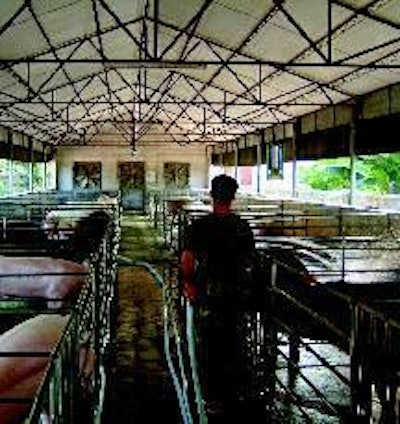
In a previous report I explained how western-style production units in China have been enjoying enhanced levels of profit despite seeing a significant rise in their input costs. Also there was the reminder that China this year has become a major importer. Going back to 2005, major problems have arisen in ensuring internal pork supply to meet a still-rising demand.
A number of major forces formed a sequence from 2005 to this year that limited the flow of pigs to market and elevated prices to their current high levels. These forces were a complex mixture of acts of nature, disease issues and social trends.
The most obvious example of a recent natural disaster hitting China is the May earthquake that affected Sichuan province. It is estimated to have disrupted the production of 4 million growing pigs. As large as this seems, however, sources now say they expect Sichuan's pork output this year will be lower only by 2-4 percent.
Mobility and disease
Then there are the social trends in the form of people's mobility and employment. Although the published charts of data from the National Bureau of Statistics and industry sources are not conclusive, numerous farm closures occurred throughout China in 2005 and in early 2006 due to low profitability.
Low farm-gate prices led to many small rural-farm owners leaving the pig sector and moving to other occupations. At this time, there was plentiful, well-paid work available on the booming urban construction projects across China. What is more, the urban developments increasingly banned pig production on small farms that had been common within and around town and city locations.
Disease added its own difficulties starting in mid-2006. From then and throughout last year, the number of pigs reaching market was decreased dramatically by the widespread occurrence of a severe syndrome known as "high fever."
The best estimates show this led to an overall loss of production of 9 percent or about 50 million pigs lost to the annual supply.
Most probably the high fever disease was due to a complex set of viruses occurring together in outbreak form. An account published in the Journal of Swine Health & Production in 2007 reported that the agents responsible were the PRRS virus, the circovirus PCV2 and classical swine fever virus. Although many vaccines are available in China and elsewhere for these viruses, vaccination is not foolproof and may not have been sufficiently practised widely prior to the outbreaks.
Since last year, the Chinese government has responded with a wide series of comprehensive intervention steps designed to limit the impact of high fever disease. This includes free vaccines, subsidies for disposal of carcases and assistance with farm hygiene measures.
Chinese authorities at federal, provincial and local levels have also instigated a range of more general measures to assist pig producers.Among the variety of schemes announced are direct subsidies for farm expansion and breeding programmes, full insurance for breeding stock and taxation exemptions and allowances.
While it has certainly had an impact, imports of pork into China have continued to increase.
Additionally, a recent decision by the Beijing administration to reduce import taxes on pork caught the eye of prospective exporters from other countries, who saw it as a clear sign of interest in facilitating foreign purchases.
Increasing output
At a production level, however, the signs from within China are clearly of an active determination to boost the number of breeding pigs and, therefore, increase the output of pigs for slaughter.
One example was an announcement of moves by the National Development and Reform Commission to allocate about RMB2.8 billion towards promoting the start of more pork production pyramids. Those completed to date represent 20,000 commercial units backed by 375 multiplication sites and 55 basic breeding farms.
Increases in inventory at breeding sites are occurring on both medium and large farms. Some are found on semi-government facilities that form part of a State Reserve.
Others are operated by key partner groups such as the major Wens organisation in the south of the country and the local arm of Thai conglomerate Charoen Pokphand. All are trying to arrange a rapid rise in their stock count.
To take another example, the China operation of breeding company PIC has grown a single grandparent herd near Shanghai into a network of multiplier farms in three provinces to supply parent stock nationally.
State-held pork reserves have been restored almost to the levels that applied before the disease situation hit farms. However, pig supply issues remain — many pigs this year continue to become sick and die from diseases; the number of deaths still limits meat supplies so that prices stay high.
More demand, higher prices
Reduced production, rising demand and higher prices still combine to give an excellent economical situation for the pig producers who have remained in business in China and have grown since 2005.
These farms now compete very favourably to those in the west in terms of production values. Their current profits are good and their long-term security seems assured.
China has not yet overcome all its challenges to producing more pork, but its heavy investments in maintaining the industry and in support of expansion and modernisation have prepared the way for a bright future.PIGI















